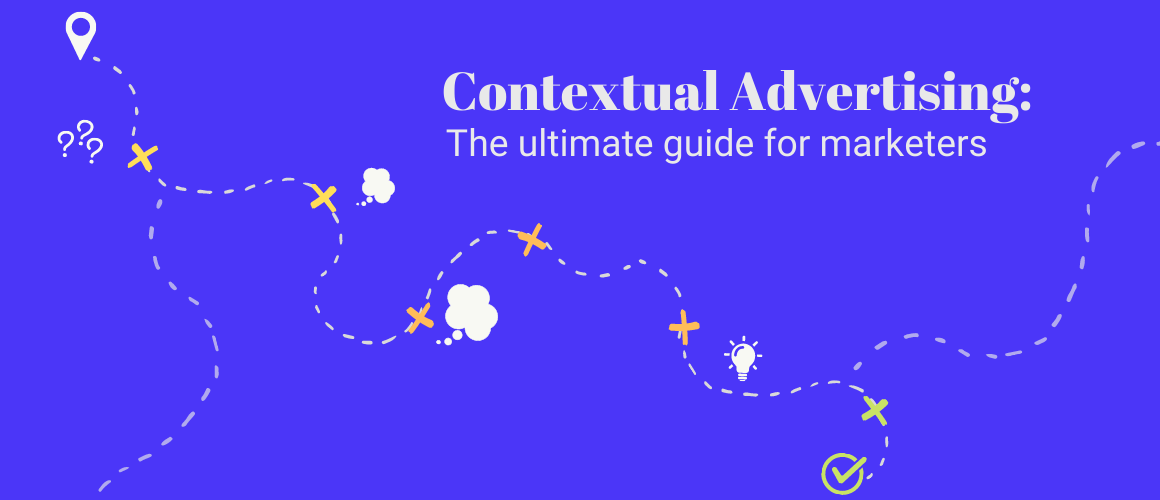In advertising, context is everything.
An ad placed next to relevant content is a lot more impactful than a misaligned ad. Not to mention, a poorly placed ad online today can put your brand's safety and reputation at risk.
Contextual advertising removes these risks and adds a laundry list of benefits to your overall strategy.
While the ad industry is constantly changing, contextual targeting has adapted to always meet it wherever it is, proving that new isn't always better.
What is contextual advertising?
Contextual advertising is based on the content of where an ad is placed. For example, an activewear brand placing an ad on a popular health and wellness website would be considered a contextual placement.
Ads are relevant to the content that surrounds them. Which also makes them relevant to users consuming that content. That's what makes contextual advertising so effective. This report found that 69% of consumers are more likely to engage with contextually relevant ads.
Contextual advertising's effectiveness isn't going unnoticed. According to Kenneth Research, spend on contextual ads is expected to reach $412 billion by 2025.
The comeback of contextual advertising
Contextual advertising isn't a new concept. It's been around for a long time. However, as new technologies emerged, contextual ads faded into the background.
So why the sudden interest in a more traditional advertising format? Aside from being effective, these are a few reasons:
Heightened brand safety
According to a study from the Society for New Communications Research of The Conference Board (SNCR), 80% of marketers plan to reduce spending with ad partners that serve ads on unreliable websites. Instead, marketers are spending their budgets with brand-safe publishers.
Advertising tactics like programmatic, make it difficult to know where all your ad impressions are being served. But with contextual advertising, you’ll be able to map back to the publishers your ads are placed on.
Ads without third-party cookies
With third-party cookies being discontinued, the advertising industry has been seeking targeting alternatives. While this has sparked some tech innovations, more and more marketers see the value in using simple strategies like contextual targeting. It proves we don't need tracking cookies and endless amounts of consumer data to target our ideal audience effectively.
Changes to consumer preferences
Consumers have become very aware of how big tech benefits from their personal data. As a result, they're no longer interested in these infringing data practices. So while third-party cookies might be out of the picture, replacing them with more technology to make up for the targeting loss ignores changing consumer privacy demands.
Contextual advertising offers a solution that's both effective and respectable.
Rise of data privacy laws
Since the tech space is relatively new, there have been little to no regulations regarding data practices until recently. However, consumer privacy laws like GDPR and CCPA have been emerging to regulate how big tech handles consumer data. While these laws are far from perfect, they are enough for companies to think twice about how they use consumer data by holding them accountable for being compliant.
Contextual targeting vs. behavioral targeting
Behavioral targeting allows marketers to target a campaign based on a user's online behavior. For example, the way they browse a website or what they've purchased in the last month.
The key difference between contextual and behavioral advertising is the targeting technique used to reach an audience. Behavioral ads use consumer data collected from their online actions to target them across the web. Contextual ads use the context of a publisher (websites, newsletters, apps, etc.) to reach users who would regularly consume that type of content.
"A second study from the series found that behavioral targeting only performed marginally better than random guessing."
While many marketers see behavioral targeting as a superior advertising practice, the data shows a different story. A series of studies published by Marketing Science looking at six demand-side platforms (DSPs) found that, on average, 41% of impressions missed the targeting mark on demographic attributes like age and gender. A second study from the series found that behavioral targeting only performed marginally better than random guessing.
Why you need a contextual targeting strategy
The customer journey today is anything but linear. Think about it, when was the last time you made an impulsive purchase decision outside of Instagram?
Consumers reach multiple touchpoints before ultimately coming to a final decision. But if consumers don't know your brand, then they have no intention of buying from it. This leaves you out of the critical decision-making phase.
Contextual advertising paves the way for that intent. By creating brand awareness early on and nurturing it at each touchpoint, your brand will be top-of-mind when the time comes to make a final decision.
And while there are many ways to increase brand awareness, contextual targeting fills your funnel with high-quality leads at scale that will translate to an increase in conversions at the bottom of your funnel.
The impact on your brand
The University of Southern California's Applied Consumer Psychology department conducted a survey and found that contextual ads were 93% more memorable than non-contextual ads. The study also found that contextual advertising significantly improves ad attributes such as brand lift, engagement, and shareability.
So what makes contextual ads so much more impactful?
They increase brand awareness in the right context. In other words, your brand aligns with consumers' intentions at that specific moment. For example, your intention to browse a health and wellness website is different from when scrolling your social media feed. If a health brand were to place an ad on either of these, the impact on the health and wellness website would be more significant.
Contextual targeting placements
Contextual advertising has naturally evolved to include a variety of placements. Here are four popular contextual ad placements to consider for your next campaign:
Native ads
Native display ads are a basic form of contextual targeting. Spend on native has grown rapidly in the last five years, with $52.75 billion spent last year alone. This growth makes sense when the click-through rate for native ads is almost 9x higher than a regular display ad.
As consumers' aversion to invasive and flashy ads grows, these small text-based ads get the message across without being intrusive.
Email ads & newsletter sponsorships
Email ads allow you to borrow a publisher's subscriber list for a fixed price giving you instant access to an engaged and relevant audience. The most traditional forms of email advertising are dedicated email sends and newsletter sponsorships.
Learn more about advertising on Flipboard here.
Sponsored content posts
Sponsored content posts sit alongside the curated content of a publisher's website. These posts typically click through to a direct-response landing page or a branded article designed to drive conversions. News and entertainment publishers like Digg and Buzzfeed typically offer sponsored content placements; however, you can also find unique sponsored post opportunities with browsers like Firefox and Brave.
Podcast ads
And finally, podcast ads. Podcasts have become increasingly popular over the years, making these voice-based ads a powerful addition to your advertising mix. This study even found that 60% of podcast listeners purchased something after listening to a podcast ad.
The benefits of contextual ad campaigns
Contextual ads aren't just making a comeback because of privacy concerns and changing consumer demands. These major changes aside, contextual advertising offers an entire suite of benefits:
Gives your brand a halo effect
Publishers put a lot of effort into building trust with their audience. When you advertise with a publisher, that trust extends to your brand. It's called the halo effect. Your ad is positively received as if it was a recommendation from the publisher itself.
Non-intrusive format
Contextual ad formats don't take away from the user experience. They enhance it with relevant information. By running ads that are contextually relevant to consumers, a simple and non-intrusive format is all you need to grab their attention.
No fees hidden in the cost
While you'll likely pay for your campaign upfront, there are no hidden fees involved like there are with other types of advertising. For example, your budget on a behavioral platform won’t all be allocated to media spend because a big percentage of it is used for other expenses such as platform fees. The cost for contextual ads is all allocated to your campaign.
The test of time
New advertising technologies that once captivated marketers are now stirring up compliance concerns and unnecessary extra work. They're failing to adapt to the changing advertising ecosystem.
Contextual advertising has always managed to stay relevant. It's managed to adapt alongside the industry, proving that advertising doesn't need to be complicated to be effective.
Strategies that stand the test of time, like contextual advertising, are the strategies worth investing in. They set you up for success in the present and fool-proof your strategy for the future.


